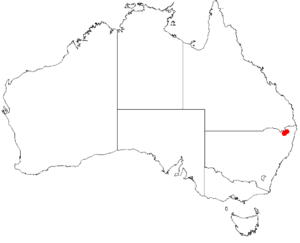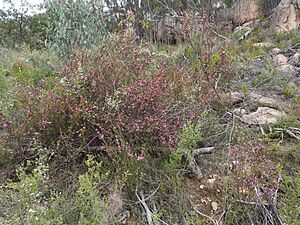Bolivia Hill boronia facts for kids
Quick facts for kids Bolivia Hill boronia |
|
|---|---|
 |
|
| Boronia boliviensis growing in the Bolivia Hill Nature Reserve | |
| Scientific classification | |
 |
|
| Occurrence data from Australasian Virtual Herbarium |
The Boronia boliviensis, also known as Bolivia Hill boronia, is a special plant found only in a small part of New South Wales, Australia. It belongs to the citrus family, called Rutaceae.
This plant is a strongly scented shrub. It has deep pink flowers that bloom in spring. Its young branches are covered with fine, yellow hairs. The Bolivia Hill boronia grows on rocky areas made of granite in the higher parts of the Bolivia Range.
What it Looks Like
The Bolivia Hill boronia is an upright shrub with many branches. It can grow to be between 0.5 and 2.2 meters (about 1.6 to 7.2 feet) tall. It has a strong smell.
When the branches are young, they are covered with tiny, yellowish, branched hairs. As they get older, they become smooth. The leaves are dark green and are made up of smaller leaflets, usually 5 to 9 of them. Each leaflet is narrow and shaped like an oval. They are about 4 to 9 millimeters (0.16 to 0.35 inches) long.
The flowers grow either alone or in groups of three. They appear where the leaves meet the stem. Each flower has four deep red, pointed parts called sepals. These are like small leaves that protect the flower bud. There are also four deep pink petals, which are about 4 to 9 millimeters (0.16 to 0.35 inches) long. Inside the flower, there are eight curved stamens, which are the parts that hold the pollen. They have yellow tips.
This boronia usually flowers from September to November. However, you might see flowers at other times of the year too.
How it Got its Name
The Boronia boliviensis was first discovered in 1995. It was officially described in 2006 by two scientists, John Beaumont Williams and John Thomas Hunter. They published their description in a science journal called Telopea.
The name boliviensis comes from Bolivia Hill. This is the only place where this special plant has been found.
Where it Lives
This boronia plant is only found in the Bolivia Range. This area is south of a town called Tenterfield. It grows in forests or shrublands. It prefers thin soil that lies over granite rock or between large granite boulders.
You can find it at high altitudes, usually between 900 and 1200 meters (about 2,950 to 3,940 feet) above sea level. It often grows near other plants like Leucopogon neoanglicus and Micromyrtus sessilis.
Why it Needs Protection
The Boronia boliviensis is considered an "endangered" species. This means it is at a high risk of disappearing forever. The Scientific Committee in New South Wales has officially listed it as endangered.
In 1999, scientists estimated that there were only about 1,000 mature plants left in the wild. This low number shows how important it is to protect this unique Australian plant.


